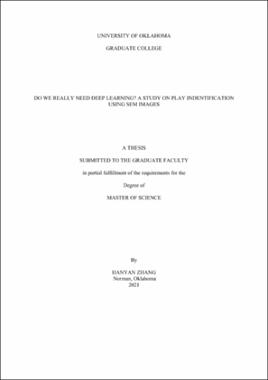| dc.description.abstract | Deep learning has become an integral part of image classification and segmentation, especially with the use of convolutional neural networks (CNN) and their variants. Although computationally expensive and time-consuming, there are several promising applications to classify or segment SEM images, images of core and thin sections. But we have not really questioned the need for really deep networks in these applications? Can shallower networks be competitive in relation to deeper networks? Can a shallower network with a wider diversity of convolutional filters (breadth) do better than a deeper network? What image resolution and filter complexity do we need to achieve a high degree of accurate classification?
In this thesis, I assess image classification using over 8000 SEM images acquired from 22 different unconventional plays to answer the questions posed above and provide guidelines to select an optimal depth and breadth for image classification. I evaluate several different CNN architectures systematically by changing the breadth (the number of filters within each layer) or the depth of the network (the number of layers) to relate classification accuracy and the complexity of the CNN. I also test the performance of the different CNN’s against different image resolutions to determine if there is a specific field-of-view that is necessary to obtain satisfactory play classification.
For all image resolutions considered, surprisingly, the simplest and shallowest one-layer model performs remarkably well with even 22 different classes (plays) to identify. Despite the simplicity of the network, I achieve over 80% accuracy in play identification (with correspondingly high recall and precision). A moderate increase in depth to 2 layers advances the accuracy to beyond 90%, even with a modest number of filters. Deeper networks that lack filter width perform poorly, indicating the significance of filter diversity in each of the convolutional layers of a CNN. The results from this study show that deeper networks are probably not necessary for image classification of SEM images/core or thin-section images. The microstructural features within the samples probably necessitate a wider diversity of filters. Finally, although several studies have relied on transfer learning of ‘published’ or open-source CNNs for play identification and image segmentation, this study shows that the level of complexity required is far less, making training more efficient and reducing the likelihood of overfitting. | en_US |
